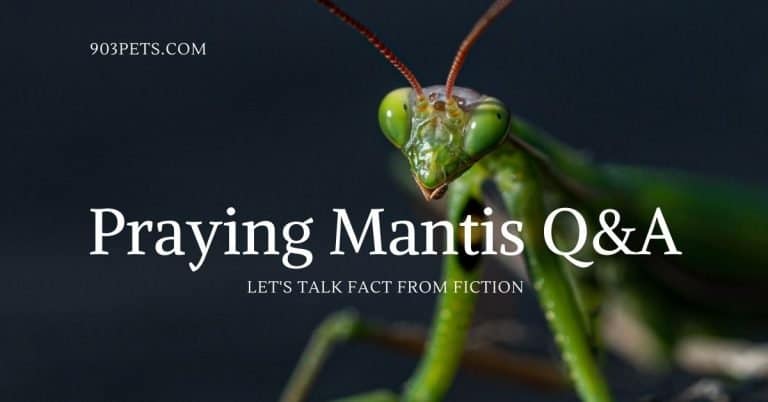Praying Mantis Pet Keeping – Beginners Guide – 101
So you’ve decided on a praying mantis as a pet insect. Congratulations, I truly believe they are one of the most fascinating pet insects you can have. One of the first questions I had is which species should I get.
So, let’s start there and move our way through all the basics in one article and you’ll be ready to bring home your first mantis.
What species should I get?
As a beginner to praying mantis pets, the Chinese mantis is one of the hardiest and most environmentally forgiving species which makes it ideal for a first-time mantis owner.

When first starting your adventure in praying mantis keeping I strongly urge you to start with the hardiest species and avoid those that need special care like the orchid mantis.
There are over 2,300 praying mantis species in the world, but only about 15 species are typically kept as pets.
The popular beginner pet praying mantis species include:
- African Mantis (S. Lineola)
- Carolina Mantis (S. Carolina)
- Chinese Mantis (T. sinensis)
- Ghost Mantis (P. Pardoxa)
- Giant Shield Mantis (R. Basalis, R. Megaera, R. Stalli.)
- Spiny Flower Mantis (P. Wahlberghii)
READ ON: What Do You Need To Know About a Flower Mantis?
Personally, I would recommend starting with either the Carolina or Chinese mantis as your first purchased praying mantis pet.
These mantises don’t have overly specialized habitation requirements and eat well. They also grow to a large size and are not overly aggressive which makes them ideal to handle with a bit of gentle encouragement.
Now that you know the praying mantis species to buy, the remainder of this guide will provide advice that applies to these starter species. Other species will have different requirements and you’ll want to dig into those more.
Enclosures & Habitats

As a general rule, a praying mantis enclosure size is derived from the mantis’ length. The enclosure should be 3x taller and 2x wider than the mantis. This is a minimum and larger enclosures, including naturalistic bioactive enclosures, can be wonderful.
The reason mantis habitats must be three times taller than the mantis itself is that when they molt, they climb to the top and hang upside-down. They need additional space to slide out of their exoskeleton without touching the walls or floor of the enclosure.
Don’t forget that the mantis lifecycle means they start small as nymphs and grow with each molting, so be prepared to start with a small enclosure and move up to larger enclosures as they mature.
When it comes to what can be used as an enclosure, most any container of an appropriate size that can be ventilated will work. You may purchase a pre-made, commercial mantis habitat or make a DIY enclosure yourself.
Anything from a large plastic pickle jar to a fancy custom built glass and screened in enclosure can work just fine. Just be sure that air can circulate to prevent stagnant air, mold growth, and mantis health issues.
Don’t place your mantis home in the dark nor in direct sunlight. You want the natural day and night cycle to keep a regular rhythm for your mantis.
You’ll need one or more branches that reach to the top of the enclosure and use coconut coir or EcoEarth for the substrate. We buy EcoEarth from Amazon. It lasts forever as a mantis substrate plus we use it for our tortoise.
Learn more about praying mantis habitats in our more detailed guide.

Temperature & Humidity
Generally, hearty praying mantis species like the Carolina and Chinese mantises will be comfortable at room temperature that you are from 71-80 Fahrenheit (21-27 Celcius). Humidity levels can be maintained by lightly misting their habitat 1-2 times per week.
When it comes to beginner species of mantises, they should not need supplemental heating in the average home interior temperature. Now, if your house typically is below 71F (21C) then supplemental heating may be needed.
This additional heat source can come in the form of an incandescent lamp, not an LED lamp. As you grow in your praying mantis pet-keeping, you could look at purchasing a reptile heating mat with temperature control that manages the temperature consistently.
At night, it is good to lower the temperature by 9 degrees F (5C) as is fairly typical in the wild. This helps with a natural day and night cycle.
The level of humidity in the praying mantis enclosure is also important. This is extra important during molting. As a beginner, you’ll keep the humidity at the right level if you mist spring water once or twice per week. The substrate should be moist but not soggy.
If your substrate is drying out, just spritz some water a little more often. If the substrate is soggy, drain the excess water off and reduce the amount of misting you due until you find the perfect balance.
Note: In Texas, it gets hot. We find ourselves needing to mist our mantises more often during the summer. Oddly enough, during the coldest parts of the winter we also have to increase our misting frequency since the heater in the house dries out the air. The point is, how much or little you mist may change throughout the year.
Water
Did you know that a praying mantis actually drinks water? It’s super cool.
Mantids also get hydration from the prey insects they eat but need additional hydration to stay healthy. Preventing dehydration is important but easily solve by misting you mantis, and it’s enclosure once or twice per week.
Yes, I said mist you mantis. I like to mist once or twice on my mantids while misting the enclosure. This places small water droplets on them that they can drink up.
Be sure to use spring or CPAP water as I understand that Chlorine and other chemicals often in tap water could be harmful your your mantis. You can also use de-chlorination drops like for aquatic pets.
Feeding
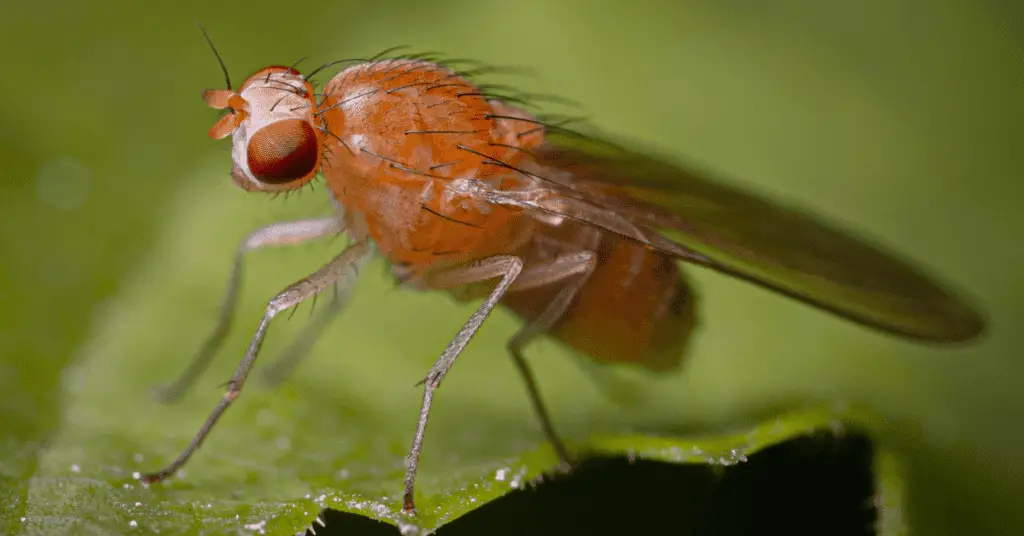
Now the fun part, praying mantis feeding time!
As a general rule, praying mantis will eat prey insects that are about the same size as its abdomen. All praying mantis nymphs will start by eating fruit flies (flightless or not) and graduate to houseflies, green bottle flies, and finally, blue bottle flies. The largest species can eat medium size dubia roaches.
As a beginner mantis keeper, let’s keep things simple. I recommend purchasing flightless fruit flies with your new praying mantis. The flightless fruit flies will be easier to keep from entering your home and are a more reliably caught meal for your mantis.
Josh’s Frogs has a great setup for these fruit flies and the foam stopper container makes it easier to transfer the flies to your mantis enclosure with fewer escapees. Heck, I just love Josh’s Frogs offerings and now you can get them through Amazon.
As your mantis gets larger, you can provide supplemental feed with an occasional meal worm or wax worm. Just know that this is in addition to regular feeder insects, and should not become a primary source of nutrition. Think of the worms as a treat, not a meal.
WARNING! Do not feed your mantis crickets! Crickets can injure your mantis, plus they can carry parasites and bad bacteria that are harmful, even deadly.
Finally, I don’t recommend capturing wild flies to feed to your mantis. It may be fine 99% of the time, but there is a possibility that the wild fly may have come in contact with an insecticide recently. Feeding that one fly to your mantis means it is now eating the insecticide which can harm the mantis.
Instead, purchase flies a few days before you need them or raise your own. We have an entire article dedicated to fruit fly medium recipes so you can raise your own.
So, how frequently do you feed your mantis? I’d recommend feeding your nymphs and juvenile mantises daily or 5-6 times per week. Once your mantis is fully grown as an adult, it may only need to be fed once or twice per week since it will not grow and further.
Molting
Molting is the process by which a praying mantis escapes its exoskeleton in order to grow. The time between molts gets progressively longer as your mantis gets older. The first molt will happen 1-2 weeks after mantises hatch and the final molt happens 2-3 months after the previous molt.
Our recommended beginner species will molt six times in their life before becoming winged adults. So, how do you know when your mantis is getting ready to molt? Here are four signs that together give you a clue that molting will soon begin.
- Refuse To Eat – In preparation for molting, mantises will refuse to eat. If your mantis is a voracious eater and suddenly stops, it could be because it is about to molt.
- Sluggishness – A mantis may move less and slower than usual as it prepares to molt.
- Fading Color – The process of molting separates the mantis from its former exoskeleton. You may not that its color because dull just before molting as a result.
- Abdominal Pulsing – It is common to see a “pulsing” in the abdomen of a mantis that is starting to molt as an act of escaping the old exoskeleton.
When it is time to molt, your praying mantis will climb to the top of the enclosure and hang upside down. It won’t eat and will move very little. While hanging upside down it will begin to extract itself from its former exoskeleton.
When it emerges, the mantis is soft and extremely vulnerable and will continue to hang for a few days while the new exoskeleton hardens. Do not try to fee, move, or disturb your mantis until 3-4 days after completing the molt.
On occasion, mantises may experience a mismolt (miss-molt). Mismolting happens when a praying mantis does not successfully molt properly. This may be from falling during the molt or losing a limb during the molt.
Should you experience a mismolt, the survival rate increases the quicker you can help it to get back to hanging upsidedown. If the mantis is until to fully escape the exuvia, there are delicate ways of helping but need an experienced hand.
It’s also good to know that if a young mantis loses say part of a leg in a mismolt, it may be able to regrow it over the next few molts. That’s pretty incredible to see. So, don’t give up hope if something like that happens. Just continue good care and appreciate them as they are.
Gender
A common early question is whether your mantis is male of female. There are a few things you can look for as your mantis matures that will give you a clue, however, these are general guidelines and some species are different.
Counting the number of abdominal segments can give you a clue to gender. Males have eight segments while females have six.
In adulthood, male mantis wings will extend further past its abdomen than females. But wings don’t appear until after their final molt so this is a late sign of gender.
Handling
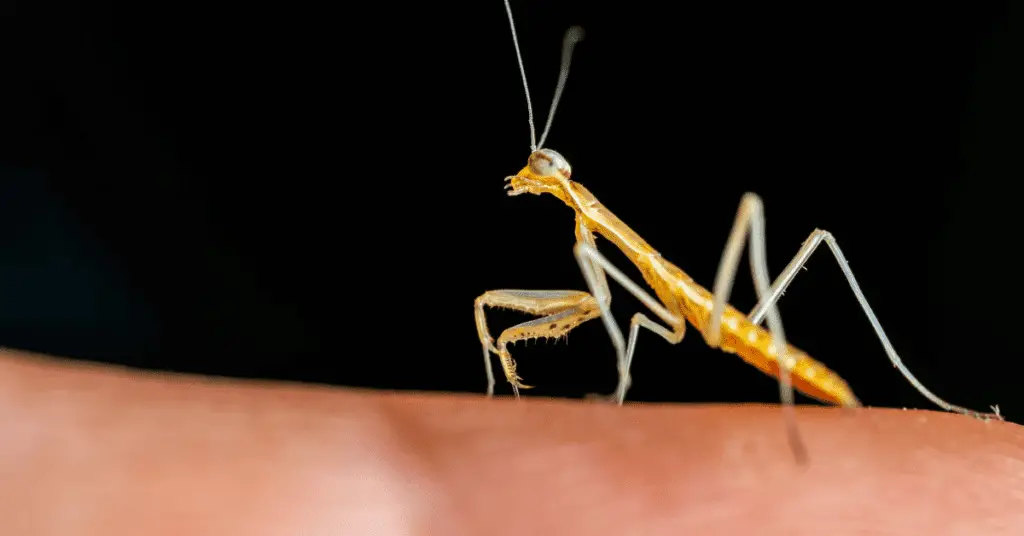
Our beginner species of mantises are hardy and excellent for first-time mantis keeper to handle. Who doesn’t want to have their darling mantis walk on their hand from time to time. But, there are a from rules you need to follow.
Keep in mind that mantises are fragile creatures despite their appearance. They can be easily injured so treat them gently.
- Mist Before Handling – Give your mantis a quick mist and wait 5 minutes before handling. Why? Well, this allows them to drink a bit of water if they need hydration. This will reduce the need for them to try to find moisture on your skin. Don’t worry, if your mantis put’s its head to your skin, it is curious or has found moisture/salt. It’s not trying to eat you. Misting before lessens this behavior.
- Wash Your Hands – Before handling your mantis, wash your hands and rinse thoroughly. Unscented soap is the best.
- Let them come to you – It is best to place your hand next to the mantis and let it decide to crawl onto your hand rather than trying to grab it from its perch. If you grab it, you can cause damage to the body and limbs.
- Hand Above – Mantises like to climb so try holding your hand or a stick above the mantis which may encourage them to climb it and discover what’s up there.
- Prepare For Escape – While mantises usually move slowly, they can jump, leap, and as adults, fly short distances. So, be prepared that your mantis may suddenly leap from your hand. So, keep them away from things that might hurt them like an open flame or a curious pet. Don’t try to catch them in mid-air as you might accidentally crush them. They won’t jump far so stay calm and coax them back to you after they land.
Ootheca
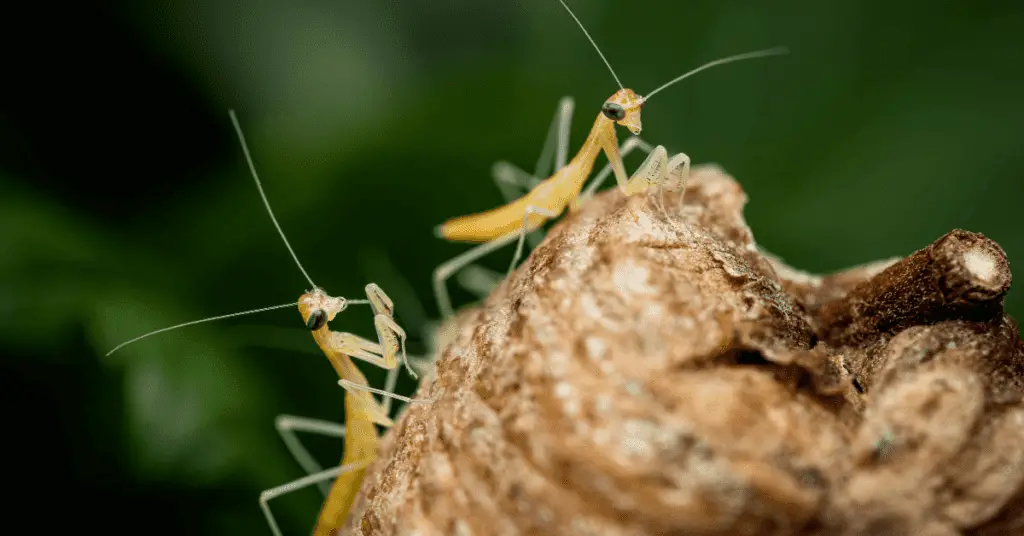
When female mantises reach adulthood, you may notice her abdomen becoming larger, even swollen looking even if she has not been around a male mantis. This is her getting ready to lay her egg sac, called an ootheca.
Female mantises lay oothecae even if they have never mated. However, if mating has not occurred, then the ootheca will not produce any praying mantises.
The female will produce a foam substance over the course of an hour or so. Just leave it for a few days until it hardens. You can then keep it there or remove it. Removing it may encourage your mantis to create another ootheca.
We have an entire article about praying mantis ootheca if you would like to learn more.
TRIVIA: Some species of mantises, like the African Mantis (Sphodromantis viridis) can produce offspring without mating. This is a type of parthenogenesis, self-reproduction. In the case of the African Mantis, the process is not commonly seen and results in only females being produced and very few actually emerge from the ootheca.
Learn more about praying mantis oothecae including tips and buyer’s guide
Next Steps
Congratulations! You are now ready to start your pet praying mantis journey. But there is more to learn. We have a more in-depth guide that you might be interested in for more details and product recommendations to get you started.
You will also get a ton of value out of these additional pet praying mantis articles:
- Praying Mantis Habitat Guide – What Matters & What Doesn’t
- How Long Do Praying Mantis Live? Praying Mantis Lifespan
- Do Praying Mantis Make Good Pets? [Pros & Cons]
- Ultimate Beginner’s Guide to Praying Mantis Pet Care
- Praying Mantis Egg Cases – Buyers Guide [Info & Tips]
- Praying Mantis Size and Environment Charts
Wrap Up
Praying mantises are a type of insect that can make for interesting and unique pets. If you’re thinking of keeping a praying mantis as a pet, there are a few things you should know first.
In this beginner’s guide to praying mantis pet-keeping, we’ve covered what species of praying mantis make good pets, what kind of enclosures and habitats they need, what to feed them, and how to handle them.
Let us know what you think. Until next time, enjoy your praying mantis insect pet!
If you think your pet is ill, call a vet immediately. All health-related questions should be referred to your veterinarian. They can examine your pet, understand its health history, and make well informed recommendations for your pet.
903pets.com Staff


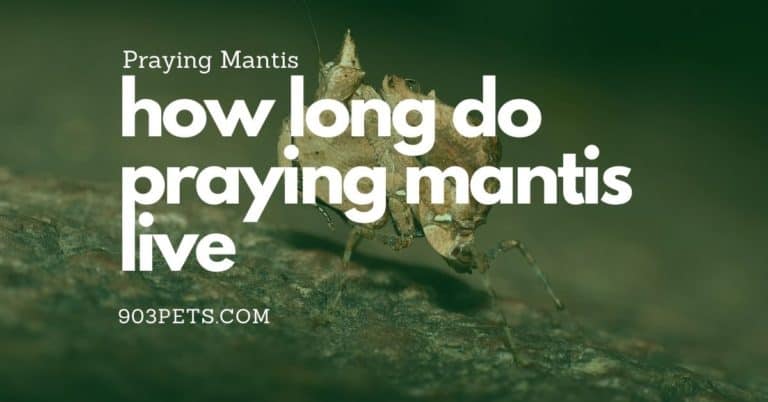


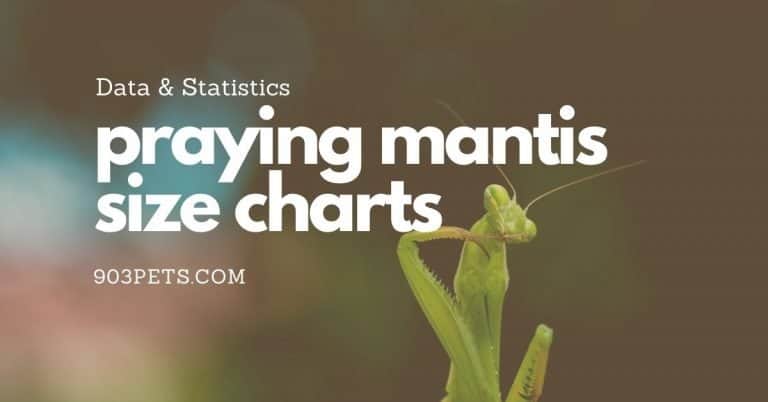
![Praying Mantis Egg Cases - Buyers Guide [Info & Tips] 15 Praying Mantis Egg Cases – Buyers Guide [Info & Tips]](https://cdn-0.903pets.com/ifywhoft/2022/05/praying-mantis-egg-cases-buyers-guide-768x402.jpg)
